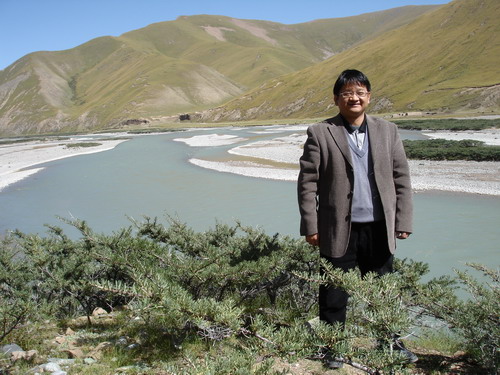
First visit to the Headwater of the Yangtze River. On Sept. 9, 2007 in Tongtianhe River in Zhiduo County, Header Water of the Yangtze River, Yushu Prefecture, this is my first time to Sangjiangyuan. Photographed by Mr. FANG Ming.
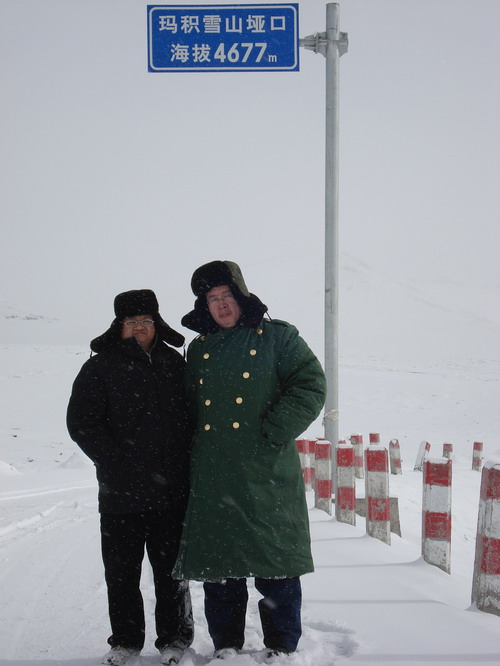
Crossed the Pass of Maji Snow Mountain. On Jan.1, 2009, Dr. WANG Jianfeng(right) and I crossed the Maji Snow Mountain Pass of the Anemaqen Snow Mountains, at an altitude of 4,677 meters in the cold winter, we encountered a heavy snow in the first day of 2009 when we traveled along the road to Dawu Town from Huashixia, Maqen County, Golok Prefecture. Photographed by Mr.Sangwa.
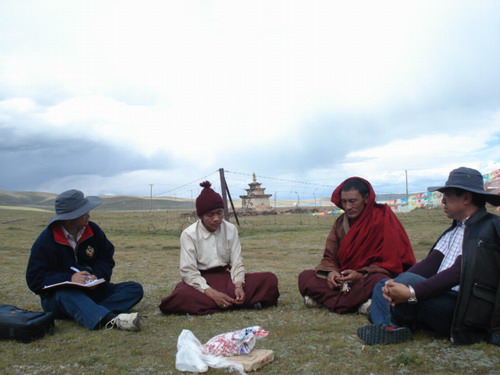
Interview in Ngoring Lake. On Sept. 6, 2009, Dhondup Tsering(right) and I interviewed to Lamas with at the grassland in front of the Cuowagaze Temple, Ngoring Lake, largest freshwater lake on upper reaches of the Yellow River, Madoi County, Golok Prefecture. Where 1,300 years ago, Tibetan King Songtsan Gambo(lived in the 7th century AD) held a splendid welcoming and proposing ceremony to the Chinese Princess Wencheng in Tang dynasty. Photographed by ZHANG Xiaomin.
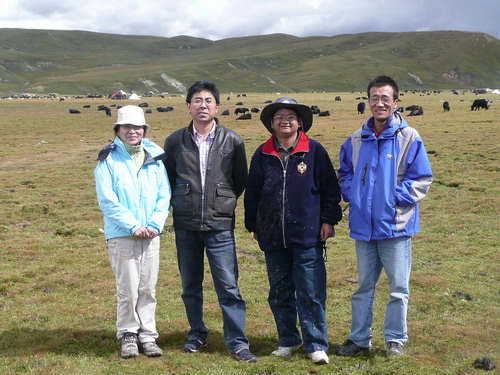
Visiting to Headwater of Langcangjian River. On Sept.11, 2009, group photo of research team in the grassland of the Source area of the Lancangjiang River/upper of the Menkong River, locates in the Youyong village, Zhuoxiao Township, Nangchen County, Yushu Prefecture. Photographed by Mr. Dongzhou Tsering.
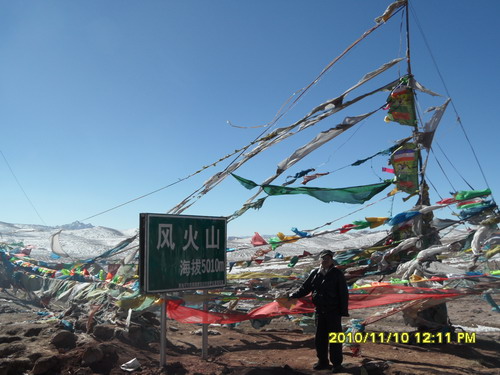
Hoh Xil Fenghuoshan Mountain. On Nov.10, 2010, I climbed to the Fenghuoshan Mountain Pass, a plateau permafrost at an elevation of 5,010 meters, locates in the Hoh Xil National Nature Reserve. The Qinghai-Tibet railway passes through there which created the world’s highest plateau permafrost tunnel. Photographed by Mr.CAO Peng.
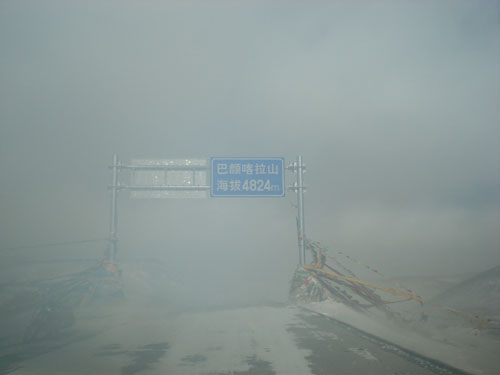
Snowstorm in Bayan Har Mountain. On 8th March 2010, we encountered a heavy snowstorm when my research team arrived at the pass of the Bayankela Shan/ Bayan Har Mountains, at an elevation of 4,824 meters. The pass is watershed between the drainage areas of the Yellow River and the Yangtze Rive, as well as the border of Madoi County of Golok Prefecture and Chindu County of Yushu Prefecture in Qinghai Province. Moreover, the mountain separates the cultural realms of Kham and Amdo in eastern Tibet.
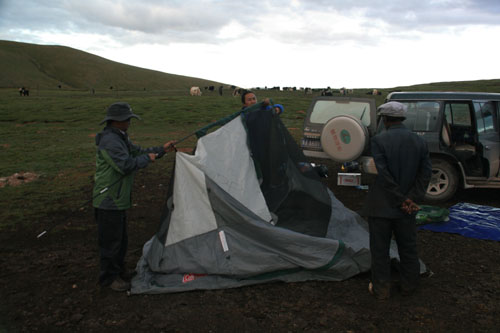
Tent on warm Yak dung. On 21st August 2010, we did the field research in a valley of Tongtianhe River, Kouqian Village , Zhahe Xiang(Township), Zhiduo County , Yushu Prefecture . The low temperature that night was around 0℃ in the summer and rained in the morning, we set up a tent there in the pile of yak dung, this is an indigenous knowledge that how warm it was in the cold night. Photographed by Mr. Lee Boyang from the Fudan University .
Field Work Experience and Research Findings on Ecological Resettlement
in the SanJiangYuan Area of Southern Qinghai Plateau
DU Fachun
Chinese Academy of Social Sciences/Institute of Ethnology and Anthropology
E-mail: dufch@cass.org.cn
Introduction and background of Sangjiangyuan
From 2008 to 2010, funded by the Ford Foundation, a research team in CASS/IEA went to the Sangjiangyuan area 5 times did anthropological field work research on ecological resettlement/migration of Tibetan herders. The project mainly focuses on the following aspects: human environment in Sanjiangyuan region, especially human-grassland contradiction; ecological resettlement process and cultural changes caused by the resettlement; evaluating the socio-economic consequences of resettled herders; migrants succeeding livelihoods and policy orientation. This group of pictures showed some of experience of research team in the Sangjiangyuan.
“Sanjiangyuan” is the abbreviation of the headwaters of the Yangtze River, Yellow River and Lantsang River (upstream of Mekong River). It locates in southern Qinghai province, with an average altitude of above 4,200 meters. It is a region inhabited by mainly Tibetan, which occupies 90% of the total population, where is large in area but small in population, and its economy depends mainly on livestock breeding. In 2003, the National Sanjiangyuan Nature Reserve was established, with a total area of 152,000 square kilometers. In early 2005, the State Council approved the implementation of “The Overall Plan of the Ecological Protection and Construction of the Sanjiangyuan Region Nature Reserve”, a total of 7.5 billion RMB or more than $1 billion will be invested for the ecological protection and construction in the region in 7 years from 2004 to 2010.
Brief research findings
According to this government project, ecological resettlement and green for grazing (converting grazing land back to grassland)were combined together, which included 55,774 herders of 10,142 families in Sanjiangyuan to be resettled on the spot of highway or moved to small towns, so as to reduce 3,184,000 sheep units. The grassland of migrant herders will be implemented grazing ban for 10 years. The herders will get a free house of 60-80 square meters and the subsidies of Yuan 8000 according to the relevant standard. After the project started, all levels of local government in Qinghai province have devoted a lot of manpower, material resources and energy, and have gained some achievement.
It is reported by official agencies and departments that substantial investment injection in environmental protection, coupled with the increased abundant rainfall in recent 2008-2010, from both natural and artificial rainfall, the ecological environment has improved in Sanjiangyuan. However, this region will still be facing challenges. On the one hand, the trend of ecological deterioration will continue in a period of time. On the other hand, the herders who resettled is struggling for livelihood, which has become a headache and the thorny issue of concern to the government at all levels and to the society.
Research finding showed that eco-resettlement policy has been increasing herder vulnerability; managing the eco-migrants is a complicated issue, most of herders cannot integrate into urban surroundings; the environmental effect of eco-resettlement is not achieved, while new problems had surfaced. In sum, eco-resettlement is not only a simple heders movement, but contains a concentrated process of traditional nomadic society shifting to settling in town, including some deeper issues such as the radical reform of production mode in pastoral area and herders’ life style. The migration and the urbanization have exerted great impact on natural ecology, social and economic structure and the inheritance of ethnic culture. The ideal way is to keep the ecological balance of livestock-pasture grazing system while the policy does not persuade the nomads to move away from their grassland.